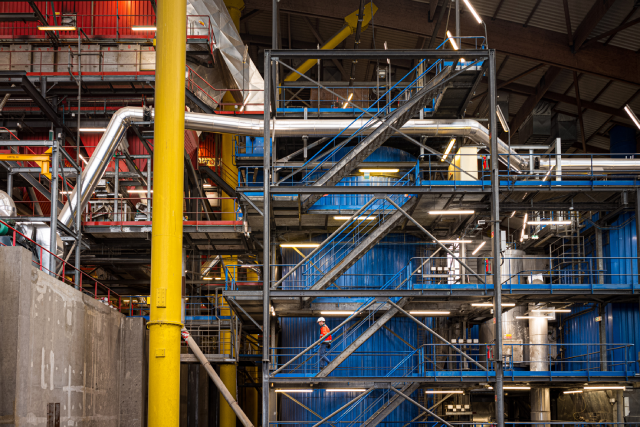Faced with the scarcity of resources, global warming, a constantly growing world population and ever-increasing energy needs, not to mention the energy crisis that hit the country in 2022 following the conflict between Russia and Ukraine, it is now urgent to make "energy" rhyme with "performance" and "independence". The good news is that Veolia is developing heating and cooling networks that provide decarbonized, low-carbon, local and affordable energy.
Heating and cooling networks: what are they?
As defined by the French Ministry of Ecological Transition and Solidarity, a heating or cooling network is "a centrally-produced heat energy distribution system serving several users". These consumers (industrial companies, private individuals, neighborhoods or apartment buildings) mainly benefit from heating and cooling networks for hot water, heating and air conditioning.
In France, heat production accounts for almost half of energy consumption, and still relies mainly on fossil fuels, which emit high levels of pollution and CO2, and are dependent on the global market. The importance of decarbonizing these networks, by using alternative energies, is no longer in doubt. This makes it possible to supply energy that is sustainable, local, low-carbon and accessible in terms of distribution and price.
Heating and cooling networks for cities and industries
A response to the energy challenge
In less than 20 years' time, 9 billion people will inhabit the planet and will need to be housed, heated and cooled, with the rise of digitalization driving a 30% increase in energy requirements. The challenge is to find the right compromise to heat and cool cities and industries with new energies. It is therefore essential to adapt solutions to local resources in order to reduce primary energy consumption and move towards carbon neutrality.
Heating and cooling networks: decarbonizing solutions
Heating and cooling networks provide solutions on the scale of a community, city or industrial basin, replacing thousands of individual heating or air-conditioning systems with a reliable, modern and economically competitive industrial system, making increasing use of renewable and upgraded energies (biomass).
Wastewater treatment plants, data centers, incineration plants, geothermal energy, biomass, etc. are all sources of electricity and heat to be exploited. The benefits? Greater energy efficiency, lower greenhouse gas emissions and renewable, local, cost-effective heat.
Heating and cooling networks: Veolia solutions
Thanks to expertise acquired worldwide, Veolia offers its customers innovative waste-to-energy solutions (biomass, solid recovered fuels-SRF) to decarbonize their energy production. An example : The Lille metropolitan area recovers and converts the steam from the incineration of 350,000 tonnes of its waste into energy to heat over 35,000 homes, reducing CO2 emissions by 50,000 tonnes each year. In Pécs, Hungary, 400,000 tonnes of CO2 per year are avoided thanks to the installation of a cogeneration plant that absorbs 580,000 tonnes of biomass fuel to produce heat and electricity, heating more than 31,000 homes and 450 public buildings. It's Europe's largest heating network powered by straw and wood!
Compared with conventional systems that separate heat and power generation, cogeneration units can deliver energy savings of up to 10%. And that's not all: CO2 emissions are also reduced by 14% compared with gas-fired plants, 24% compared with oil-fired plants, and 28% when coal-fired.
There’s also the energy "lost" during production or transport. This is the case of waste heat, which until recently was "lost" because it was not captured. Today, it is recovered in situ or externally, in heating networks. Data centers are a perfect illustration of this. While these facilities use a great deal of energy, particularly via their cooling systems, they also lose a great deal. It is precisely this energy that escapes into the atmosphere that is recovered and put to good use, as is the case in Brunswick, Germany, helping to make these facilities energy self-sufficient. Another example is the "Heat Highway". This project, developed in conjunction with the Lille European Metropolis (MEL), involves creating 40 kilometers of underground pipes to facilitate the circulation of water heated by the combustion of metropolitan household waste. The aim? To supply the MEL's heating networks through waste-to-energy conversion. The result? The emission of 50,000 tonnes of CO2 avoided every year.
Unique in Europe, the 5th generation heating and cooling network of the Etablissement public d'aménagement Paris-Saclay, managed by Veolia. The program includes the development of an ambitious energy mix combining deep geothermal energy, waste heat from the CNRS supercomputer and heat recovery from the cooling network. With the aim of doubling the power of the network by 2028, equivalent to the average consumption of 10,000 homes each year, and ensuring a renewable and recovered energy rate of over 50%, this urban energy exchange infrastructure enables the buildings connected to it to become alternately producers and consumers of heat and cold. In concrete terms, several student residences are equipped with advanced energy demand management systems, enabling them to smooth out peaks in heat consumption on the network and increase the proportion of renewable energies.

Greenhouse gas reduction, energy independence, resource conservation, regional resilience...
district heating and cooling networks provide concrete answers to the needs of a more sustainable world.


